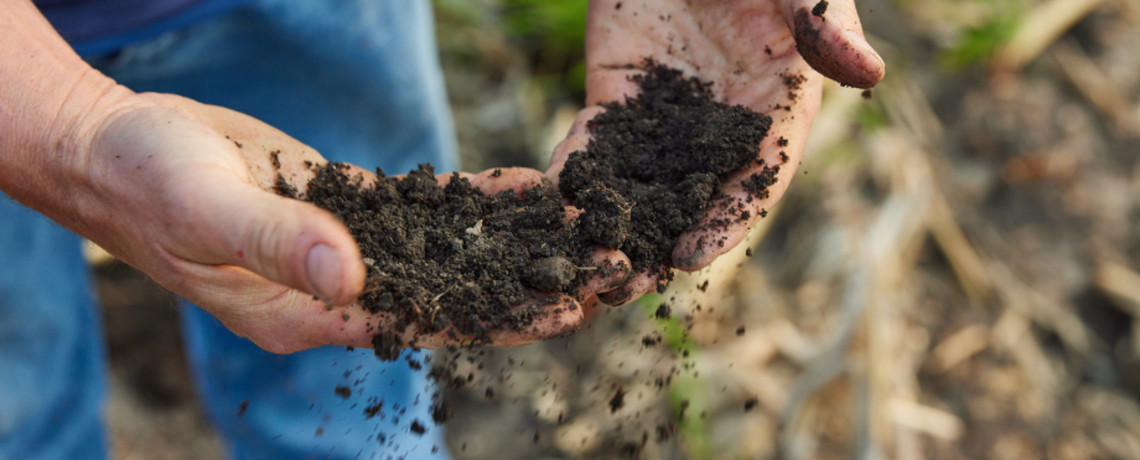
As Good as Gold: How to Safeguard the Value of Your Soil
Written by: ForGround by Bayer
When it’s healthy, soil can perform like a well-oiled machine.
Farming practices that support soil health can help producers work with the land to reduce erosion, manage water infiltration and improve nutrient cycling. Plus, farming healthy soil might require less inputs and ultimately help farmers improve the resiliency of the land they farm.
But, how do you know whether your soil is healthy —and whether your farming practices establish a benchmark to sustain the land for future generations?
Visual indicators like organic matter, physical properties and biological characteristics are tell-tale signs of soil health that can help you safeguard black dirt to ensure it is truly worth its weight in gold.
Look Close: What’s in your soil?
Assessing the value of your soil goes beyond results gathered from a laboratory analysis.
“Soil health is more about function than test result,” explains Zach Larson, a sustainable systems agronomist with Bayer. “That’s the benchmark. Is the soil doing the things you want it to do?”
He adds, “Soil structure tells a lot of the soil health story. If you know the differences in soil structure between platy, granular, and blocky, then you can pull out a relatively intact slice of soil, break that apart, examine it and diagnose structure.”
So, grab a shovel and head to the field as you consider these three visual assessment steps that can help you establish a benchmark for soil quality.
Step 1: Organic matter
According to the USDA’s Natural Resources Conservation Service, organisms in the soil surface are key to decomposition of soil organic matter as well as nutrient cycling, soil pollutant degradation and the formation and stability of soil structure.
Organic matter feeds soil microbes and helps drive the release of nutrients into the ground, Larson says. Tillage and residue management can alter soil conditions, impacting organic matter content in the soil.
You can bolster soil organic matter by:
- Minimizing soil disturbance. Limit tillage, optimize chemical inputs and rotate livestock. Some disturbances might be unavoidable but remember that minimizing events across an operation helps build healthier soils.
- Maximizing soil cover. Plant cover crops. Use organic mulch. Leave plant residue. A general rule is to cover soil whenever possible.
- Maximizing biodiversity. Plant diverse cover crops. Use diverse crop rotations. Integrate livestock. Adding biodiversity across your operation can help break disease cycles, stimulate plant growth, and provide habitat for pollinators and other organisms living in the soil. The presence of soil life, including earthworms, is a good indicator of soil value, Larson says.
- Maximizing presence of living roots. Reduce fallow. Living roots not only help reduce soil erosion but also provide food for organisms like earthworms and microbes that cycle nutrients for plant needs.
Step 2: Physical
From bulk density, infiltration, soil structure and macropores to soil depth and water holding capacity, the physical properties of the land determine the retention and transportation of water and nutrients through it.
The physical properties of the soil provide habitat for soil microbes and can yield an estimate of crop productivity potential, compaction, water movement and tilth.
“If you start to see granular structure in the soil, that’s generally indicating you’re going in the right direction,” Larson explains. Several conservation practices can help improve infiltration rates.
Conservation crop rotation as well as cover crops, prescribed grazing, residue and tillage management, and waste utilization all result in infiltration rates favorable to soil function.
Step 3: Biological
Are there earthworms in your soil? If so, that’s a positive indicator of soil health. According to NRCS, earthworms improve soil tilth, aeration, infiltration and drainage.
“Look at plant roots to see how they’re moving through that slice of soil,” Larson explains. “You should be looking for presence of soil life.”
Microbial biomass carbon and nitrogen, particulate organic matter, soil enzymes, soil respiration and total organic carbon also favor quality soil.
These biological indicators help provide insight into the living components of the soil. Land management, natural disturbances and even chemical contaminants can directly impact the soil’s living organisms.
Tillage management – including no-till, strip till and ridge till – as well as planting cover crops and rotating species with legumes can boost earthworm populations. Applying manure and other organic by-products can also aid biological soil qualities.
Make the Time
Determining soil value doesn’t need to be a lengthy, drawn-out process. Most often, Larson says you should be able to sample and provide a good, thorough, visual appraisal of the soil yourself.
While digging, seeing and knowing how a crop goes through the soil are keen observations you realize firsthand, Larson adds that technology can also provide insight into soil value.
Through planter technology, farmers can learn how much downforce is required to plant a particular area. “We can even get some estimates of organic matter from our planters,” Larson says. “The most important thing in cases such as testing different metrics that might change through the season, like permanganate-oxidizable carbon or respiration, is to test at a consistent time of year and to be consistent with the conditions in which samples are being pulled.”
Know the Value
Determining the health of your soil can be a valuable first step toward putting a successful crop in the bin at harvest. And conservation management practices are key to ensuring your soil is good as gold.
Taking time to see what’s really in your soil and how the soil responds to those management practices can make all the difference in safeguarding its value for future generations.
This article was written by Trust In Food in collaboration with Bayer.